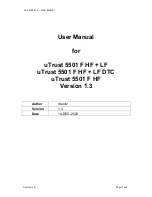
1-2
Overview
KPCI-3110 and KPCI-3116 User’s Manual
Introduction
This manual is provided for persons needing to understand the installation, interface require-
ments, functions, and operation of the KPCI-3110 and KPCI-3116 boards. These board types
differ in analog I/O resolution, throughput, and D/A filters as shown in
Table 1-1
.
NOTE
Unless noted otherwise, this manual refers to both models collectively
as KPCI-3110.
This manual focuses primarily on describing the KPCI-3110 boards and their capabilities, set-
ting up the boards and their associated software, making typical hookups, and troubleshooting.
There are also sections that discuss calibration and summarize characteristics of DriverLINX
test-panel software.
Features
The KPCI-3110 and KPCI-3116 boards are high-speed, multifunction board types for the PCI
bus. These board types differ in analog I/O resolution, throughput, and D/A filters as shown in
Table 1-1
.
All KPCI-3110 and KPCI-3116 boards share the following major features:
•
32 Single-ended or pseudo-differential analog input channels (refer to), or 16 differential
analog input channels.
•
Programmable bipolar (±10V) and unipolar (0 to 10V) input ranges with gains of 1, 2, 4,
and 8.
•
Continuously-paced and triggered scan capability.
•
A 1024-location channel-gain list that supports sampling analog input channels at the same
or different gains in sequential or random order.
•
Up to 256 scans per trigger for a total of 262,144 samples per trigger.
•
PCI bus mastering for data transfers.
•
Pre-, post-, and about-trigger acquisition modes to acquire data relative to an external event
using computer memory.
•
Internal and external clock sources; one external clock input for the analog input subsystem
and one external clock input for the analog output subsystem.
•
Analog threshold triggering using either an external analog input or one of the analog input
channels; a separate DAC sets the trigger level (8-bit resolution, fixed hysteresis).
•
Digital TTL triggering; one external hardware TTL input for the analog input subsystem and
one external hardware TTL input for the analog output subsystem.
•
Two analog output channels with a ±10V output range.
•
Simultaneous analog input and analog output operations running at full speed.
•
Software calibration of the analog input and output subsystems.
Table 1-1
Differences among KPCI-3110 and KPCI-3116 boards
Board Type
Analog I/O
Resolution
Output
FIFO Size
A/D Throughput
(Single Channel)
D/A Throughput
(Full Scale)
D/A Filters
KPCI-3110
12 bits
4 kSample
1.25 MSamples/s
200 kSamples/s
-
KPCI-3116
16 bits
4 kSample
250 kSamples/s
100 kSamples/s
0 and 20kHz
Содержание KPCI-3110
Страница 3: ......
Страница 4: ......
Страница 7: ......
Страница 8: ......
Страница 16: ...Preface...
Страница 20: ...1 Overview...
Страница 25: ...2 Functional Description...
Страница 54: ......
Страница 55: ......
Страница 57: ......
Страница 58: ......
Страница 59: ......
Страница 61: ...3 Installation and Configuration...
Страница 66: ......
Страница 68: ......
Страница 80: ......
Страница 81: ......
Страница 82: ......
Страница 83: ......
Страница 84: ......
Страница 85: ......
Страница 86: ...4 Testing the Board...
Страница 89: ...5 Calibration...
Страница 92: ...6 Troubleshooting...
Страница 99: ...A Specifications...
Страница 111: ...B Connector Pin Assignments...
Страница 116: ...C Systematic Problem Isolation...
Страница 143: ...D Using Your Own Screw Terminal Panel...
Страница 156: ......
















































